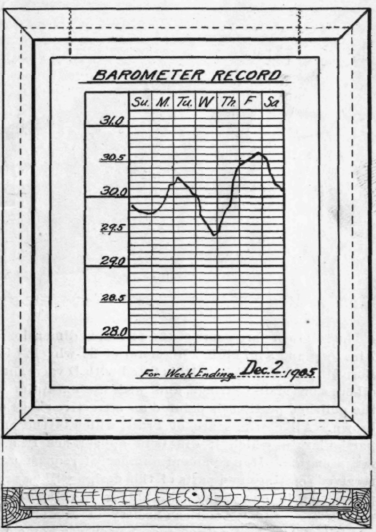A Barometer In The Home
Description
This section is from the book "Amateur Work Magazine Vol5". Also available from Amazon: Amateur Work.
A Barometer In The Home
H. M. Chadwick
The barometer, always an ornamental instrument, is easily discovered to be interesting and instructive also, if one takes the readings and records them rightly.
This can be done by means of the accompanying chart, which is arranged to cover a period of one week. The writer takes two readings daily, one in the morning just before starting for work, and one in the evening upon his return. This method is tolerably satisfactory, although of course one at midnight would give completer record.
The chart should be drawn to a full size scale in black ink on transparent paper or tracing-cloth; it should then then be pur, into a printing-frame with an unexposed negative, and printed onto the negative by exposure to lamplight. Care must be taken to get a negative and not a positive image on the plate. To do this place the face or ink side of the paper against the film. Develop the plate in the ordinary way, and print as many copies of the chart on blue print paper as may be desired.
The holder for the chart is made as shown in the cut and is to be fastened to the wall beside the barometer. The top moulding is removable to permit the changing of the charts each week.
Although the barometer is an instrument for recording the atmospheric pressure, its office is often misunderstood. Many people, seeing the words rain, change, fair, and so forth, on the dial, think that it is primarily a weather prophet. It does incidentally prophesy the weather, however, and the following rules are subscribed as being generally applicable:
"Generally the rising of the mercury indicates the approach of fair weather; the falling of it shows the approach of foul weather. In sultry weather the fall of the mercury indicates coming thunder. In winter the rise of the mercury indicates thaw, and its tall indicates snow. Whatever change of the weather suddenly follows a change in the barometer may be expected to last but a short time. Thus, if fair weather follow immediately the rise of the mercury, there will be very little of it; and in the same way, if foul weather follow the fall of the mercury it will last but a short time.
If fair weather continues for several days, during which the mercury continually falls, a long succession of foul weather will probably ensue; if foul weather continues for several days, while the mercury continually rises, a long succession of fair weather will probably succeed.
A fluctuating and unsettled state of the mercurial column indicates changeable weather. "
These rules were given to the public in a lecture by Professor Lardner in 1846, and in his opinion they should be princed and sold with every barometer.
Prof. Lardner says: "It would be right, however, to express the rules only with that degree of probability which observation of past phenomena has justified. There is no rule respecting these effects which will hold good with perfect certainty in every case."
The terms rain, change, etc., are very misleading, as with a change of altitude the mercury assumes a different height, or in the aneroid, the hand moves along the scale without regard to the weather conditions.

Section
An instrument which is often called a barometer but which, properly speaking, is not, is the "little old man and little old woman " so common on our mantle shelves. This taking invention is really a hygrometer, since it indicates the degree of moisture in the air, and nothing else. The old man is popularly supposed to come out in stormy weather, and the old lady to appear with the sun; but on fine days with a humid atmosphere, the man is always out. The couple are interesting to watch, especially when they are observed in connection with the barometer. They should be placed out of doors in a sheltered spot where they may be seen from within, as under a porch near a window. This open air exposure is necessary, in winter at least, for the hot, dry air that comes from the furnaces of most of our dwellings causes the old lady to remain out for weeks at a time, if kept indoors.
Continue to:


